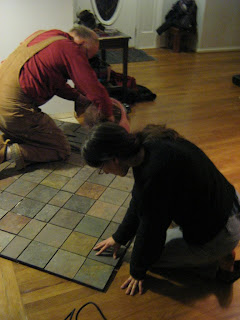It's been an unusually cold winter in the high country, with two major snows and two ice storms. The largest ice storm came on Christmas Eve and left large parts of Ashe and Watauga Counties without electricity, in many cases for days. Below are our willow trees, which were hit particularly hard by the ice.

Anyway, it's the sort of weather that makes you appreciate a good heat source. So we worked very hard in December and early January to get a second woodstove in the house. Below: stripped molding, cement board, and some plastic storage containers used as a mock-up of the stove. Makes you feel warm just looking at it, right? We sited the stove near an interior wall, close to the center of our living room-dining room-kitchen, and pretty close to the stairs... we're hoping it can heat the living spaces and the bedrooms upstairs.
We have wood floors, so we had to build a hearth. The cement board is mostly used to stabilize the hearth tiles and provide a good adhesive surface for the mortar and cement. It also probably prevents the wood floor underneath from getting hot. We used HardieBacker(tm) -- the best cement board money can buy.
In the end we decided to go with slate tile, which has a more natural look than most of the manufactured tiling we could find. The disadvantage to slate is a lack of uniformity. Tile thickness and size varied considerably. Fortunately, such differences disappear quickly under the expert guidance of tiling veteran Ed Perzell (below, with Kristen) who helped us a lot through this project.
Below: grouting. As you can see, grouting leaves a beautiful white coating over the tile, which gets into every crack and crevice and can only be removed by tootbrush. My knees hurt just thinking about it.
The almost-final step was the border. We found a stone tile border that matches the slate. The diagonal pattern of the border also complements the diagonal arrangement of the tile. The border comes in strips backed by a kind of plastic webbing -- this makes it much easier to install.
Below is the finished product. All it's missing is a stove and some kind of molding around the hearth border.
Installation day was a lot of fun. It was one of the warmest days of the winter. We bought and had our stove installed by Mountain Home and Hearth in Boone, who were great from start to finish. The sales manager provided us with a lot of advice, calculations, and re-calculations while we were figuring things out, and when we were finally ready, the installers were great.
Below is the first fire in the new stove. It is not like the old stove, which is in our basement. It heats a larger area with less wood, is easier to light and keep lit, burns cleaner, burns for longer periods of time (up to 18 hrs according to the manual), and is much nicer to look at.
It's a Harman Oakwood. Modern woodstoves are very different from the behemoth we have in the basement (or any old woodstove). For one thing, they either have catalytic converters or some other design mechanism that allows for complete combustion of the wood. If you burn wood below a certain temperature, a lot of the volatile gases simply leave through your chimney as pollution. New EPA-rated woodstoves have what amounts to an "afterburner" which allows these gases to ignite at low temperatures, which translates to less pollution and more heat.







